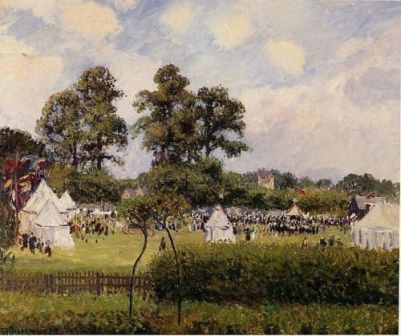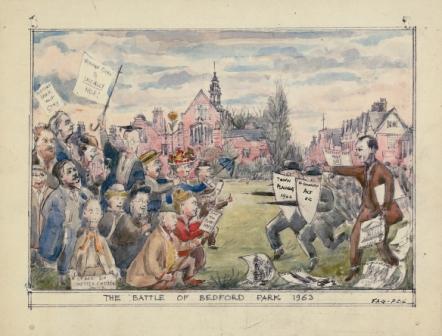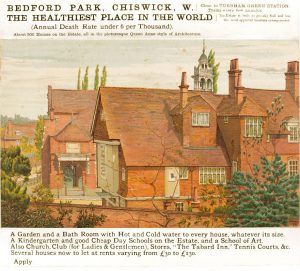St Michael & All Angels Church lies at the heart of Bedford Park, a residential area developed between 1875 and 1886 and acclaimed as the world’s first “garden suburb” – forerunner by over thirty years of Letchworth and Welwyn Garden City. Map of the Parish of Bedford Park
The development owed much to the “Aesthetic Movement” of the 1870s, and attracted a community of artists, architects and other aesthetic types, with its promise of a “village-like” community living in “sweetness and light”.
 The influential Victorian architect, Norman Shaw, succeeded E.W.Godwin as Estate Architect for Bedford Park and designed St Michael & All Angels Church and several of its first houses, in a distinctive “Queen Anne Revival” style, using red brick and white joinery.
The influential Victorian architect, Norman Shaw, succeeded E.W.Godwin as Estate Architect for Bedford Park and designed St Michael & All Angels Church and several of its first houses, in a distinctive “Queen Anne Revival” style, using red brick and white joinery.
The area rapidly became a showpiece and was praised by William Morris and others. Notable resident artists have included J.B.Yeats, father of the poet W.B.Yeats; Lucien Pissaro, whose father Camille produced several paintings of Bedford Park (though some were actually in Stamford Brook, left), and T.M.Rooke, friend of Ruskin and pupil of pre-Raphaelite artist Burne-Jones.
In his autobiography G.K.Chesterton notes that Bedford Park, so strikingly unusual to begin with, had by 1936 so far merged with the rest of London that it had become hard to remember how odd it appeared at the beginning. He felt that, in a sense, Bedford Park had ‘conquered’ the rest of the world.
H owever, by the late 1950s a different picture began to emerge, and the area was starting to deteriorate. This was partly owing to the relentless march of bed-sitter land, and also through the post-war penchant for burying the past; Victorian buildings in particular becoming unfashionable. As a result, the local councils began to knock down some of the larger houses in the area, to build new housing.
owever, by the late 1950s a different picture began to emerge, and the area was starting to deteriorate. This was partly owing to the relentless march of bed-sitter land, and also through the post-war penchant for burying the past; Victorian buildings in particular becoming unfashionable. As a result, the local councils began to knock down some of the larger houses in the area, to build new housing.
In 1963, a pioneering conservation campaign began, with the formation of the Bedford Park Society under the patronage of Sir John Betjeman (pictured right in ‘The Battle of Bedford Park’. In 1967, after an exhibition of the architecture of Bedford Park at St Michael & All Angels vicarage during the first Bedford Park Festival, the Government agreed to give Grade II listing for 356 of the Bedford Park houses, as well as the public buildings. This was an unprecedented measure for such an area, as the idea of Conservation Area status did not exist at that time. As a result, Bedford Park was designated a Conservation Area in 1969 – one of the first in the country.
You can also read more on St Michael’s World War 1 Project website and the Victorian Society website.
St Michael & All Angels Church has been an active supporter of the Chiswick Timeline, from which the top image on this page is taken, courtesy of Foster Books. Painted by F Hamilton Jackson, it was one of several lithographs commissioned in 1882 by Bedford Park’s founder Jonathan Carr to promote the estate, using the bold – but hard to substantiate – claim ‘The Healthiest Place in the World’. In 2018-2019, this iconic image of St Michael & All Angels was displayed in an exhibition at the Wellcome Collection alongside other images of the first garden suburb. The free exhibition – ‘Living with Buildings’ – examines the impact of architecture on our health and wellbeing. It ran from October 4th 2018 to March 3rd 2019.
A second in the series of lithographs – (right) by T.M. Rooke (see above) – shows the porch and cupola of St Michael & All Angels and the back of The Tabard, and was one of several lithographs commissioned in 1882 by Bedford Park’s founder Jonathan Carr to promote the estate. The church doors and gates are now white.
In 2024, the original (and restored) Tabard Inn sign painted by TM Rooke was displayed in the Michael Room in St Michael & All Angels Parish Hall. See picture below and ‘Restored Tabard sign now hangs in Michael Room’.
See more pictures in ‘Bedford Park: Pictures from the Past’ by Sandra Grant and DW Budworth.

